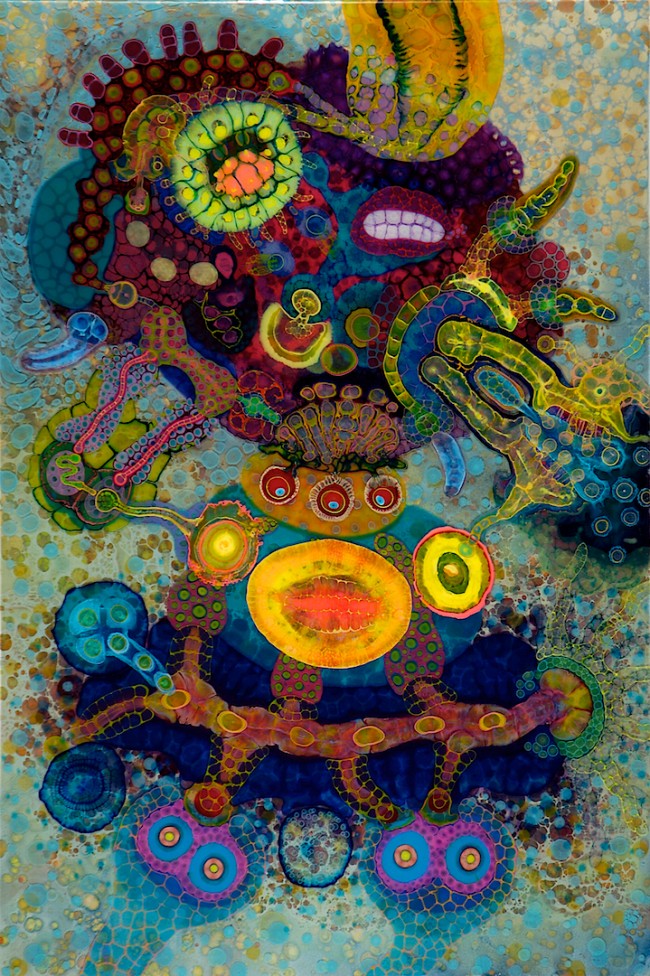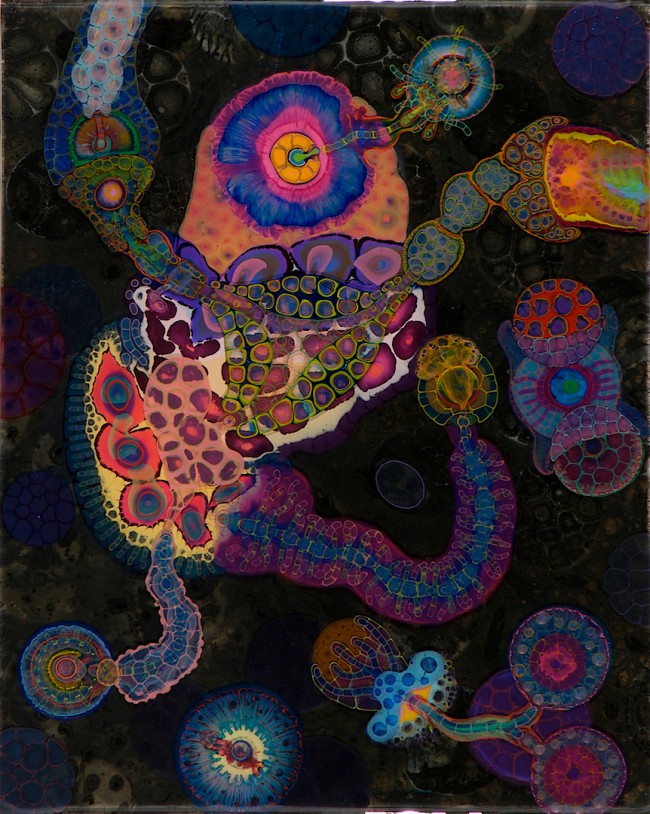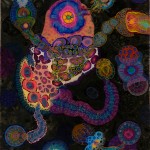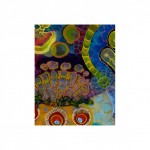Bruce Riley’s Science Fiction, at Miller Gallery
by Matthew Metzger
Bruce Riley’s lyrical, organic forms glow through layers of paint and resin, resembling something we can’t quite remember, materializing from a ground we can’t quite locate, coalescing with other forms, then receding back into the abyss. The coalescence is like the moment in between sleep and consciousness when thought coagulates, dancing between dream and reality. The forms are the dream almost remembered. The abyss is the forgetting of the dream, back to wherever lost memories of dreams go. Surrealism doesn’t have sole claim to draw from dream-states, and Riley is no surrealist, but biomorphic abstraction certainly has roots in Surrealism, Riley’s nebulous forms included. His paintings and process reveal themselves upon a bit of analysis (to use a Freudian word), if you’re the type that seeks revelation. I prefer not to know, a sort of blissful ignorance.
Riley’s process, by the way, is well documented. At risk of oversimplifying, if you must know, it goes something like this: traditional painting techniques are used to apply paint between thick clear coats of resin, again and again. Mistake and accident are welcomed. Luminosity is created by light refracting through these layers. This isn’t necessarily new, although Riley’s process and mark-making are very much his own. And he has the discipline not to deviate. Of course, the best part of this work lies outside process and technique (I’ll get there). But Riley sticks to his process in keeping with the paradoxical notion that freedom is found by voluntarily imposing restrictions. An encouraging thought and one we might embrace more often in a world with instant access to just about everything, except simplicity and a certain grace.
Process really only matters if the final product matters. And these paintings are very good (full disclosure: like Riley, I’m also represented by Miller Gallery, although I had never met him until this show). Riley doesn’t limit his subject to the Greenbergian formalist notion that abstraction should be purely abstract (this notion of course is, arguably, an impossibility). Riley’s biomorphism is about expanding reality, not forbidding it. It is in keeping with the relatively short (and largely European) history of biomorphic abstraction, starting with Matisse, to Dali’s and Tanguy’s surrealism, used eloquently by great modernists like Miro, Henry Moore, Hepworth, Noguchi, Gorky and even Lucio Fontana, and referenced more recently by Louise Bourgeois. As a nod to this history, a Miro-esque eye stairs at us from Riley’s Succubus, a glowing decorative surface (admittedly, sometimes overly so) penetrating our modernist past and staring through us, the viewers, into the unknowable future.
Most of Riley’s paintings depict amoeba-like forms emerging, hovering or crawling from the depths of Riley’s ground as if amphibians from water to land. These amphibious forms are a metaphor: like amphibians, the paintings are in the process of becoming. After all, the “morphism” part of biomorphism refers to transformation, encompassing the idea of change as constant. The “bio” part, of course, refers to life. Riley’s paintings free us to think about “the nature of nature,” as Paul Klee may say. Or the life of life.
What of Riley’s large scale paintings depicting seemingly microscopic views? A reflection on ourselves at this moment in time and space; the equivalent of quarks in cosmic time? Speaking of quarks and cosmic time, Riley often references quantum mechanics and astronomy in his work. His references to science via biomorphic abstraction are at their best references to, on one hand, the empirical, visual world and on the other, the world which we cannot see but can only intuit. Hence the title to the show, Science Fiction, which makes sense if the two words are considered separately. Paintings have titles like Super Collider, a particle accelerator used to provide insight into the subatomic world, Holomovement, the paradoxical concept coined by physicist David Bohm that encompasses the wholeness of everything and at the same time the continual process of becoming, and Higgs.
Higgs must refer to Peter Higgs, who in 1964 proposed the existence of a massless elementary particle that spontaneously gains mass by interacting with a “field”. The existence of the Higgs particle was confirmed in March 2013 (a nanosecond ago in the grand scheme of things). This “field” helps to explain the origin of mass, which is to say everything. It is quite possibly the original source, without irony. This is one of those discoveries that enlarges our notions of reality, just like all good painting. Is Riley’s ground, often black, referencing this “field”, his forms the elementary particle? In any event, the discovery is important, the implications of which reach far beyond science into religion, mysticism, poetry and art, hopefully helping to get rid of the silly dualisms that likely should’ve never penetrated our western thoughts in the first place. This all gets rather complicated, and I’m dramatically oversimplifying. Suffice it to say that the more we know about Riley’s paintings and quantum mechanics, the more questions that arise. This is a good thing. So enter both of those rabbit holes at your own risk.
Matthew Metzger is an artist, designer and furniture maker based in Cincinnati. His paintings are represented locally by Miller Gallery, and his furniture by Voltage, as well as other galleries and design showrooms nationally. His website is www.metzgerfinearts.com.
- Incubus 30×24
- Incubus – detail 1
- Coat of Snow 72×48
- Coat of Snow – detail









